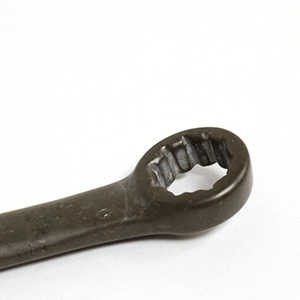LLAVE MIXTA
Carved stone
15 x 2,5 cm
(Text that was part of the curatorial research for the solo exhibition of Sonnia Yepez in La
Tertulia museum, 2018)
The stone age is another age.
The wounds and the materials of an archeologist are his second and minute hand to
measure time beyond time. When everything must be imagined, the stone age exists only as
an image. Differentiates from the immediate past, the history, the document, and the tale
that have corporeality and consequences in light of a structural framework of signs (the
stone can be read as a document).
We only have the stone and the science to comprehend a world that is hard to conceive
before history or even before life. Thus, thinking about the stone age is contradictory since
it does not have a genesis nor ending as life and history seem to have. Both are under the
need to have in capital letters the start (birth, name), and final periods to end, as things
could end...
The stone only has itself. It grows and decreases without being seen. It exists as a tree that
falls in the lonely forest where the stone becomes the only testimony of its fall, dust, and
dirt adhered to her. It is the testimony of the strength the earth made to compress matter
into a single stone or to divide a big one into several ones.
The stones that were going to be thrown at the woman accused of adultery (according to the
Bible) probably, today hold a door or hold the grill of a bonfire…
That being said.
The natural stones after being out there for many years started to be extensions of the
human beings’ passions. They were hit and before reading them (reading their ages, or what
was written on them), they began to keep another testimonial: the emergence of a life that
not only gave use to the stone but meaning. Some stones are still adored in representation
of a presence, or something far even beyond projected from the worshiper’s head. And by
doing so, a symbol is thrown on the stone.
That being said,
Writing came as the possibility of turning the idea into stone by introducing it and giving it
shape. Better said, converting the idea into a forceful object.
Yet…
If the idea is a tautology (not a forcefulness but a loop, paradox, or a poem), how would the
stone’s forcefulness allow such softness? On one side, it has been converted into God, a
relic, a thing, or a sculpture. Its function (from which the stone is no longer a testimony but
its form and use) has been consolidated not only by a planet that gathers matters, but by a
being that gathers subjectivities. On the other hand, because it is indifferent to all this.
In other words, how would the writing on the stone allow the malleability of language?
Then,
Art, alchemy, and spirituality are the closest things to the transmutation ability the human
being has. It is like if he had that capacity without having it; however, he still does not.
There is an art, closed, and tautological, in whose practice the stone is a stone, and the
subjectivity is not thrown on it as the stone is no longer a body nor a symbol. But is thrown
into the system of art in which that stone arrives and paradoxically can aspire to be a stone
again.
That being said,
A game that was necessary is inserted. This is the clash of words inside the same system of
art where the stone was already stone, and now seems to be something else: a mixed key
carved in gray marble from Santo Tomás de México. Everything around the silence of its
“looking like” is tautological: a tool that is not a tool, but it is still a stone under a
conventionalized design. It is under industrial standardization parameters… Quite contrary,
but upon itself.
As if it was possible to be two things at the same time, the stone is the closest thing to a
transmutation. As the stone could be two things at the same time, and its forcefulness had,
for a moment, the vacillation of any softness. Like a sculpture and a deception; like a tool
and an object absolutely useless but whose use must be found with any pebble stone:
potential tool, that is, potentially in itself.
Breyner Huertas
http://www.xn--letrapequea-beb.info/





